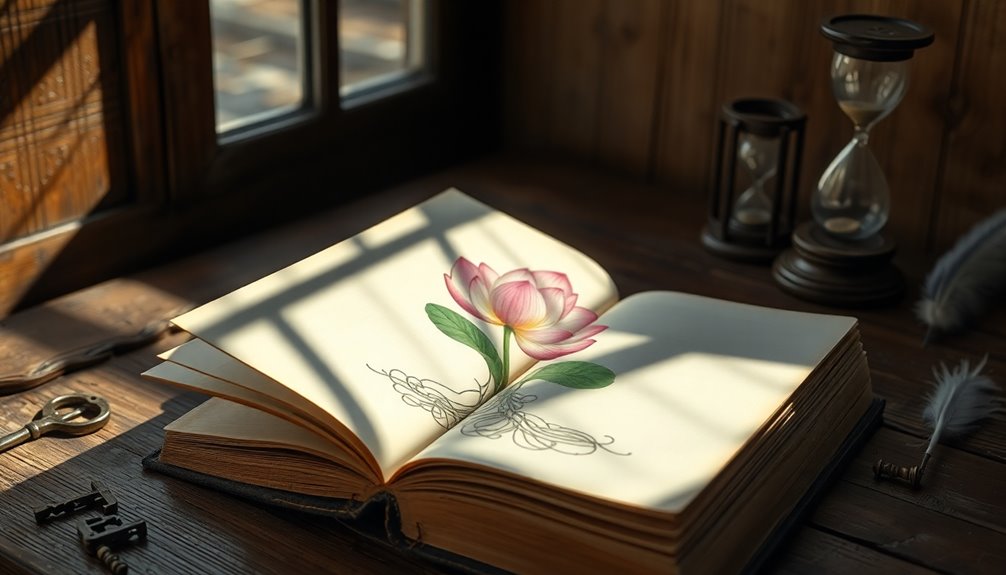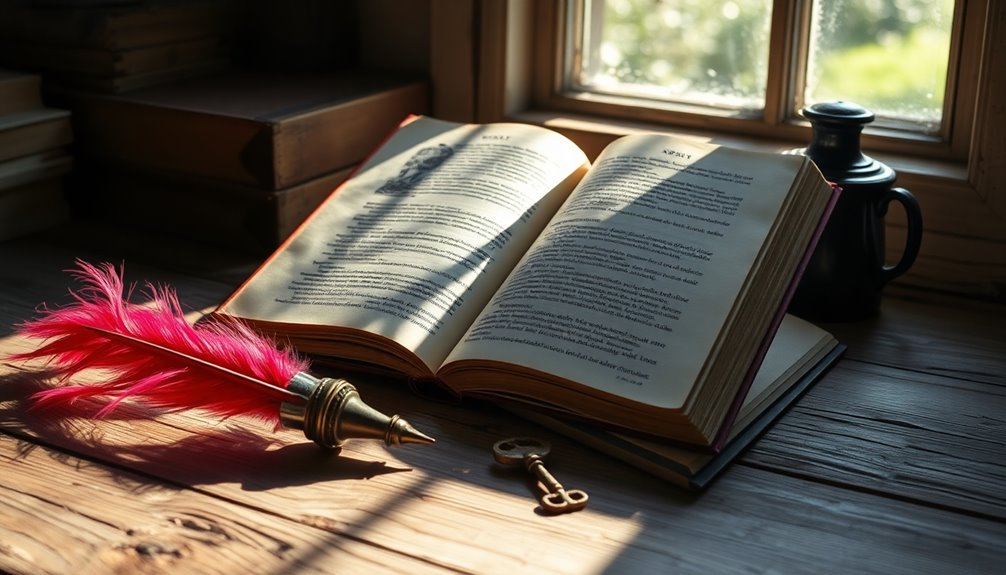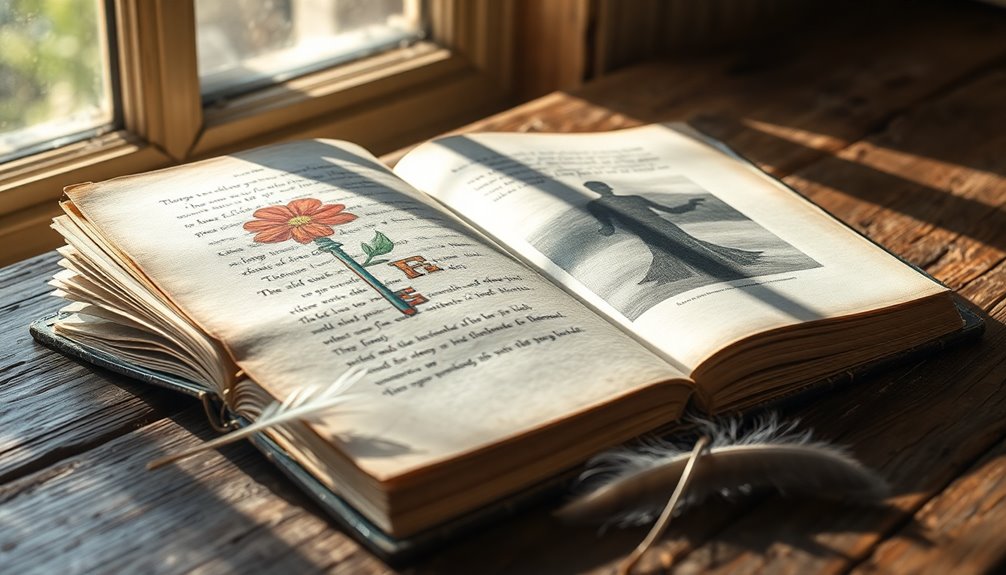Authors use symbolism in literature to share deeper meanings in fun and engaging ways. By using symbols, like objects or colors, they can express complex ideas and emotions that connect with you. For instance, a heart often symbolizes love, while a wedding ring represents commitment. This artistic choice makes stories richer and helps you feel what the characters experience. It also invites you to think critically about the layers of meaning hidden in the text. So, as you continue on your journey, you'll discover even more fascinating insights about the symbols authors choose and what they truly represent!
Key Takeaways
- Symbolism enriches narratives by allowing authors to explore complex themes in a profound and layered manner.
- It creates emotional connections with readers, engaging them on a deeper level through relatable imagery.
- Authors use symbolism to reflect cultural significance and personal experiences, enhancing relatability.
- Symbolism maintains narrative flow, seamlessly integrating deeper meanings into storytelling without disrupting progression.
- It encourages critical thinking, prompting readers to uncover varied interpretations and insights.
Understanding Symbolism

Symbolism in literature is a powerful tool that authors use to convey abstract ideas through concrete images. When you read a work of literature, you might notice that certain objects, colors, or actions have special meanings. This is symbolism! It helps in conveying complex themes and emotions without lengthy explanations. For example, when an author mentions a heart, it often symbolizes love.
There are different types of symbolism, like conventional, accidental, and universal. Each type serves to enhance your understanding of the story.
The context of the story can affect what a symbol represents. For instance, the color black can symbolize death in one culture, while in another, it might represent elegance.
Importance of Symbolism in Writing

A writer's use of symbolism can substantially enrich a narrative, allowing for a more profound exploration of themes and emotions. By employing symbols, you can reveal deeper meanings that make your story more engaging. Symbolism in literature acts as a powerful tool that helps convey complex themes without lengthy explanations, keeping the narrative flow smooth and enjoyable.
Using representational imagery, you create layers of meaning that invite readers to think critically about the text. This encourages them to connect with the story on a personal level, resulting in strong emotional responses. Additionally, effective symbolism can reinforce recurring themes, providing a cohesive structure that binds the narrative together.
Here's a table showing the importance of symbolism in writing:
| Aspect | Impact |
|---|---|
| Depth of Narrative | Enhances exploration of complex themes |
| Reader Engagement | Creates emotional connections |
| Cultural Significance | Resonates with personal experiences |
| Narrative Flow | Maintains smooth progression in storytelling |
| Layers of Meaning | Encourages critical thinking and analysis |
Incorporating symbolism will certainly make your writing richer and more impactful!
Identifying and Interpreting Symbols

How can you effectively identify and interpret symbols within a text? First, you'll want to pay close attention to objects, actions, or characters that seem to represent something more than their literal meaning. Authors use these symbols as a literary device to convey complex themes and emotions.
Next, consider the context. The author's background and the cultural setting of the story can greatly influence the meaning of symbols. This is important because what a symbol represents might change based on these factors.
Look for recurring motifs, too! These repeated elements can guide you to understand the broader themes and ideas the author wants to express.
Finally, be open to different interpretations. Each reader brings their own experiences and cultural perspectives to a text, which can lead to unique understandings of symbols. Embrace this diversity in interpretation!
Types of Symbolism

Throughout literature, various types of symbolism enrich the storytelling experience and deepen the reader's understanding. You'll find that authors use different symbols to represent ideas, emotions, and themes. Here's a quick look at some types of symbolism:
| Type of Symbolism | Description | Example |
|---|---|---|
| Metaphors | Implicit comparisons that reveal deeper meanings. | "Time is a thief." |
| Allegories | Extended metaphors throughout a story. | "Animal Farm" critiques power. |
| Conventional Symbols | Meanings tied to culture or literature. | A wedding ring means commitment. |
| Universal Symbols | Recognized meanings across cultures. | A heart symbolizes love. |
| Color Symbolism | Colors evoke specific emotions or ideas. | Red represents passion. |
| Object Symbolism | Physical objects represent larger concepts. | A ladder symbolizes growth. |
Resources for Writers

Understanding the various types of symbolism can greatly enhance your writing, but knowing where to find resources that specifically address these concepts is just as important. Here are three great ways to dive deeper into symbolism:
- Courses at Writers.com – They offer fantastic classes focused on imagery and symbolism in poetry and prose. You'll learn how to use symbols effectively in your writing. Additionally, exploring cultural symbols can provide rich layers of meaning to your narratives, which aligns with the concept of nurturing an imaginative mindset. Understanding how symbols can reflect vibrational states may also inspire deeper connections in your storytelling.
- Community Feedback – Engage in workshops or comment sections to get constructive criticism. Other writers can help you see your symbolism from a fresh perspective.
- Editing Tools like AutoCrit – This resource helps refine your writing, suggesting improvements for your symbols and imagery, ensuring they're meaningful and impactful.
Additionally, consider subscribing to newsletters for monthly tips on incorporating symbolism. Writing prompts can also spark your creativity, encouraging you to explore new symbolic ideas. Understanding the importance of art theory in creativity can also provide valuable insights into the use of symbolism in your literature.
With these resources, you can develop meaningful symbols that resonate in your stories, making them truly special. So, go ahead and check out these tools; your writing journey will be all the more exciting!
Frequently Asked Questions
Why Does an Author Use Symbolism in Their Literary Piece?
An author uses symbolism in their literary piece to share deeper meanings and emotions in a fun way.
When you see a symbol, it helps you connect with the story on another level! Symbols can make themes shine brighter and keep you guessing about what happens next.
They also create moods that pull you into the world of the characters.
What Is the Purpose of Using Symbols?
The purpose of using symbols is to express big ideas in a simple way. When you see a symbol, it can represent feelings or themes that make the story richer.
For example, a heart might stand for love, while a storm can show trouble. Symbols help you connect with the characters and their journeys.
They invite you to think deeper about what's happening and make the story more exciting and relatable!
What Effect Does Symbolism Have on the Audience?
Symbolism can create magic in stories! When you see a symbol, it often makes you feel something special or think deeply about what's happening.
For example, a bird might stand for freedom, making you imagine flying high. It connects you to big ideas without using lots of words.
Plus, when you spot symbols again and again, they help tie everything together, making the story even more exciting and memorable to you!
How Does Symbolism Affect a Story?
Symbolism can really change a story! When you see a symbol, it often represents something bigger than itself. For example, a rose might symbolize love.
This adds layers to the story, making it more exciting and meaningful. You might feel different emotions or think deeper about the characters' actions.
Plus, when symbols repeat, they create motifs, connecting ideas and themes. So, symbolism helps you engage more with the story and understand it better!
Conclusion
To sum up, symbolism adds a special magic to stories, letting you see deeper meanings behind the words. Did you know that more than 70% of readers love finding hidden symbols in books? It makes reading exciting! By understanding and using symbolism, you can connect with stories in a whole new way. So, next time you read, keep an eye out for those sneaky symbols. You might discover something amazing that changes how you see the tale!











